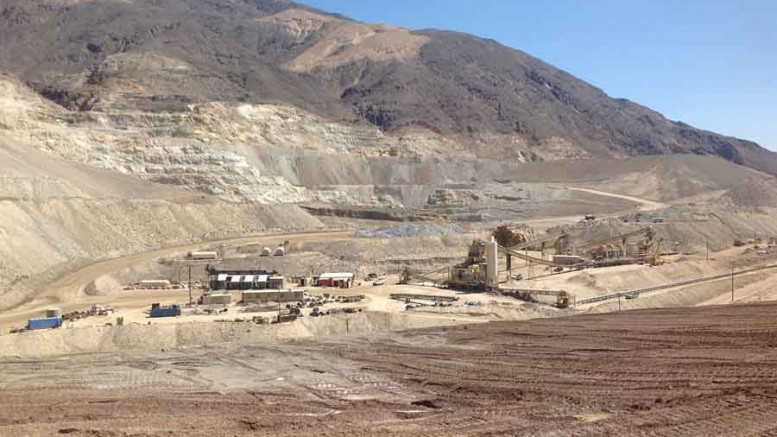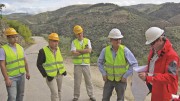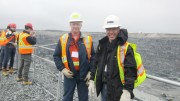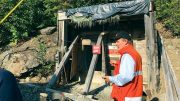INYO COUNTY, CALIF. — If all goes according to plan, 2013 could be a banner year for junior gold producer Atna Resources (ATN-T) and its portfolio of advanced-stage gold assets in the southwestern U.S. With one gold mine cranking out cash in eastern California, Atna has the luxury of using that capital to bring its Pinson underground gold mine near Winnemucca in Humboldt County, Nev., into commercial production later this year.
In California, Atna’s wholly owned Briggs open-pit, heap-leach mine lies along a dusty stretch of road off Highway 178 on the edge of the Panamint mountain range, roughly 80 km east of the town of Ridgecrest.
A thin layer of brackish water is all that remains of a nearby lake, which glimmers and throws off mirage-like waves in bright September sunlight. Buckwheat and cacti dot the desert terrain, made famous by the nearby Death Valley National Park.
“Where we are currently, is with the grandfathered permits we’ve been operating under,” president and CEO James Hesketh says, who has been involved with Briggs since he helmed previous operator Canyon Resources. “And those are full mine permits. Last year we completed our environmental assessment for the Gold Tooth South area, and received permits for the stripping you saw that is going on now. So we do have that ability to permit and expand the footprint.”
Atna restarted operations at Briggs in 2009 after the mine had produced 740,000 oz. gold during operations that ran from 1996 through 2004. Though gold was initially discovered north of the project in the late 1800s, commercial-scale production was not recorded until the 1970s when Harry Briggs kick-started underground development, with lower-grade mineralization feeding production ever since.
As it stands Briggs isn’t a long-term asset, with proven and probable reserves totalling 11.1 million tonnes grading 0.69 gram gold per tonne for 247,000 contained oz. gold. However, additional measured and indicated resources clock in at 30.5 million tonnes at 0.69 gram gold for 662,000 contained oz. gold, which will allow Atna to realize production at Briggs through at least 2017.
“We’re pushing the Gold Tooth pit both to the south and to the north,” Hesketh explains, noting that the main source of mineralization in the Briggs system is the Gold Tooth fault, which runs through the active pit. “The extension is moving along that fault system, and we’re actually mining the fault out with the mineralization on the hangingwall side. You can get high grades close to the fault itself. We had designed an underground mine at one time, but we’ve since redesigned the pits, and it is basically mining out everything we would have taken underground.”
During a site tour, operations at Briggs are just getting back underway following maintenance on a factory-rebuilt jaw crusher. Atna took its secondary crusher off-site for repairs during the second quarter of 2012, and suffered through roughly three weeks of downtime as a result. The company used this time to adjust its tertiary circuit and fix up its screening plant and conveyor systems.
“We have three crushers there, and one of them is brand new. We’ve spent a lot of money on rehabbing the plant and related equipment,” Hesketh says.
The operation hums with activity as a tour group gathers at the bottom of the Gold Tooth pit. Trucks rumble by and kick up dust as miners work on the pit expansion and stockpile ore for crushing and leaching.
“It’s a mesothermal-type system and gold is late-stage or advanced, so it tended to occur on the outside of the particles,” Hesketh says when asked about Atna’s processing circuit. “It is not encapsulated, so on a recovery basis it is a surface-area versus recovery game — and that’s why we’ve developed a crushing profile where we create surface exposure to get those gold recoveries.”
Despite challenges at Briggs, Atna saw its year-on-year gold sales jump 14% during 2012 to 36,460 oz. — though overall production fell on the lower end of the company’s guidance at 36,928 oz. As a result the company reported US$19.3 million in cash to end 2012, despite development at Pinson.
Atna expects output at Briggs to fall between 37,000 and 45,000 oz. gold during 2013 at cash costs in the US$850 to US$900 range. Atna’s main challenge during the coming year will involve supplying ore to its crusher plant, as waste-stripping ratios rise due to development at the Gold Tooth South and Briggs Main North pits. Strip ratios are expected to rise from around 2.2 to 3.8 in 2013.
Hesketh says Atna tries to complete a reserve upgrade at Briggs every second year. He points out that even though the mine was opened with an expected life of six years in the mid-1990s, the deposit offered up exploration upside that extended operations, and promises to continue doing so.
“We’ve got some potential, and being a mesothermal system it could have tremendous depth extent. So underground definitely remains a possibility,” he says. “We haven’t done too much drilling at depth, and you saw the high walls out there, and the steepness of the mountains. In order to get a good handle on the underground, we’re going to need to drift in and drill off the underground workings. There just aren’t good drilling locations where we currently sit. We’ll be looking at that over the next couple of years.”
Over in Nevada, underground development at Pinson continues to move the project towards production, and on schedule. During 2012 a total of 360 metres of new ramp access was completed, as well as two ore production stopes. The company also completed a major permit modification that will allow it to operate at an increased mining rate in the 360,000-tonne-per-year range.
Pinson’s underground is expected to contribute between 65,000 and 70,000 oz. gold to Atna’s production profile in 2013, at cash costs from US$900 to US$950 per oz. That would bring the company’s total gold output to 110,000 oz. in 2013, at costs averaging between US$880 and US$930 per oz. gold.
“Pinson is going quite well, and our contract miner is well up to speed,” Hesketh says, noting that local miners have a working knowledge of the types of ground conditions the company will encounter. “There have been issues in that part of the country with the mineralization in the deposits having been extensively altered. The country rock we’re dealing with is primarily a limestone, which provides good waterway channels. The difference with Pinson is that it runs a lot more vertical than some other deposits. That nature means that we’re forced to support less ground, so really your only concern is about supporting in the ore stopes themselves.”
Pinson is another example of Atna’s strategy of capitalizing on development-stage gold assets in a bid to grow its production profile without the typical lag time in earlier-stage exploration. Pinson produced 985,000 oz. gold from 1980 to 1999 when it operated as an open pit, but Atna’s focus is on a higher-grade underground resource totalling 2.3 million measured and indicated tonnes grading 12 grams gold for 1.06 million contained oz. across the Ogee, Range Front, CX and CX West zones.
As a bonus, Atna executed a non-exclusive ore milling and gold-purchase agreement with Barrick Gold (ABX-T, ABX-N) to process Pinson ores at Barrick’s nearby Goldstrike mine complex.
Thanks to the area’s infrastructure advantages, Atna spent just US$21 million on Pinson in 2012, and expects a final price tag of US$28 million. The operation will use conventional underhand cut-and-fill mining, and is slated to hit a 900-tonne-per-day target by the end of 2013.
As Pinson’s underground mine moves towards full production, Atna will be studying a
restart of open-pit, heap-leach mining at the site. The company’s development concept includes a production target of between 75,000 and 100,000 oz. gold annually from the pit, which could operate independently of the underground mine.
Open-pit resources at Pinson total 23 million measured and indicated tonnes grading 1.32 grams gold for 982,000 contained oz. gold.
“We have the resource for the Pinson pit, which is oxide that trends to depth into mixed oxide and sulphide. When we declared that resource, we used economic drivers that didn’t take into account whether any of that material was leachable,” Hesketh explains. “We’ve now drilled a series of metallurgical holes, which are in the lab, to work on those recoveries. And we’re just initiating the bidding process for the open-pit engineering, which will lead to a reserve declaration.”
In November Atna released results from four large-diameter core holes it drilled to confirm continuity in Pinson’s open-pit mineralization and acquire metallurgical samples. The drill program demonstrated strong continuity in the past-producing Mag pit, with highlights including 47 metres grading 1.97 grams from surface in hole 1, and 49 metres of 3.36 grams gold from 102 metres depth in hole 2.
Next in Atna’s development pipeline is the Reward open-pit heap-leach operation, 9 km southwest of Beatty, Nev. Similar to Briggs in scope, Reward is expected to carry a US$34.5-million development price tag and produce 35,000 oz. gold per year for Atna. Reward has proven and probable reserves of 10.8 million tonnes grading 0.75 gram gold for 266,000 contained oz., as well as 16.4 million measured and indicated tonnes at 0.69 gram gold for 363,000 additional in-situ oz.
Hesketh predicts exploration efforts will be in full swing at the Reward site in early 2013. “We do have mineralization there with a shallow dip, so we’re doing step-outs down the bedding. It is quite simple in terms of targeting, though again we have to prove the model. We’ll also be doing some condemnation drilling there around the planned sites.”
Atna predicts Reward could produce at low cash costs of US$592 per oz. over a seven-year mine life, and generate non-discounted cash flows totalling US$133 million per year at a US$1,500 per oz. gold price.
A little further on down the developmental road is Atna’s Columbia gold-silver property 72 km northwest of Helena, Mont. The company plans to start permitting the project this year, which may take around four years to complete.
Montana state law prohibits cyanide-based gold recovery at an open-pit mine. As such, Atna has run preliminary metallurgical work on Columbia mineralization that indicates 90% to 94% recoveries using conventional gravity and flotation methods.
Atna has not completed an economic study on Columbia since 2010, when it released a preliminary economic assessment that pegged potential annual production at 70,000 oz. gold and 96,000 oz. silver per year at cash costs of around US$639 per oz. gold.
At US$900 per oz. gold and US$15 per oz. silver, Columbia carries a US$51-million pre-tax net present value and a 16% internal rate of return using a 5% discount rate. The study identified measured and indicated resources totalling 15 million tonnes grading 1.19 grams gold and 2.75 grams silver for 741,680 contained oz. gold and 2.14 million contained oz. silver. Atna is aiming to produce 300,000 oz. gold per year when its full gold portfolio is in production.
The company is going about it a bit differently than its peers, however, by identifying smaller capital projects with near-production potential that can incrementally add ounces at low development costs.
With capital costs on the rise at so many large-scale gold developments worldwide, Atna’s embrace of relatively low-cost and low-risk projects in established jurisdictions may appeal to investors and shrink the valuation gap between share price and in-situ gold ounces seen in many producers.
“We’re really prioritizing our development targets along the lines of what provides the highest possible returns. Now — because the Pinson open pit is adjacent to the underground, and we have an existing team and infrastructure on-site — I anticipate that will be quite a high-return project for us,” Hesketh says. “The issue is that it is not permitting at this time, so the engineering will gear towards developing a mine plan that we can use to start the permitting process . . . that’s why we give it two to three years in our timeline. A corner of it is on [federal land], and the rest is on private ground. We’re going to be assessing a couple of phases to see if there is an impact on developing federal versus private.”
And that could lead to a big jump in market valuation if Atna is able to meet its development targets.
The company’s shares have traded within a 52-week range of 76¢ and $1.54, and have trended much tighter to start 2013, with prices ranging from $1 to $1.28 per share.
Atna has 145 million shares outstanding and closed at $1.12 at press time, which equates to a $162-million market capitalization.






Be the first to comment on "Atna poised to capitalize on US gold portfolio"